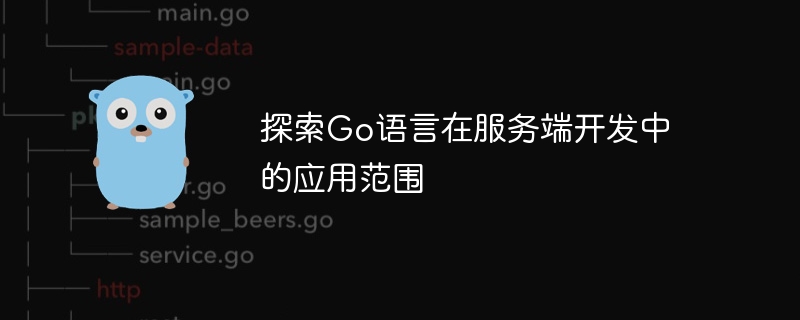Home >Backend Development >Golang >Explore the application scope of Go language in server-side development
Explore the application scope of Go language in server-side development
- WBOYWBOYWBOYWBOYWBOYWBOYWBOYWBOYWBOYWBOYWBOYWBOYWBOriginal
- 2024-03-16 10:03:041162browse

Go language, as a programming language with high efficiency, superior performance and easy-to-use, has been widely used in server-side development in recent years. This article will deeply explore the application scope of Go language in server-side development, and provide specific code examples to help readers better understand and master this powerful programming language.
1. Web service development
In the Internet era, Web service development is an important part of server-side development. The Go language allows developers to easily build high-performance web services through its excellent concurrency capabilities and efficient performance. The following is a simple code example for building a web service using Go language:
package main
import (
"fmt"
"net/http"
)
func helloHandler(w http.ResponseWriter, r *http.Request) {
fmt.Fprintf(w, "Hello, World!")
}
func main() {
http.HandleFunc("/", helloHandler)
http.ListenAndServe(":8080", nil)
}In the above code example, we define a helloHandler function to handle the client's request and use the http.HandleFunc method to connect the processing function with the URL Paths are associated. Finally, a simple Web service is implemented through the http.ListenAndServe function to start the Web server and listen to port 8080.
2. API Development
With the development of technologies such as mobile applications and front-end and back-end separation, API development has become an indispensable part of server-side development. Go language provides a rich standard library and framework to make API development easier and more efficient. The following is a sample code for writing an API using Go language:
package main
import (
"encoding/json"
"net/http"
)
typeUser struct {
ID int `json:"id"`
Name string `json:"name"`
}
func userHandler(w http.ResponseWriter, r *http.Request) {
user := User{ID: 1, Name: "Alice"}
jsonResponse, _ := json.Marshal(user)
w.Header().Set("Content-Type", "application/json")
w.Write(jsonResponse)
}
func main() {
http.HandleFunc("/user", userHandler)
http.ListenAndServe(":8080", nil)
}In the above code example, we defined a User structure to represent user information, and wrote a userHandler function to handle / Request for user path. Convert the structure to JSON format data through the json.Marshal method, and return JSON data by setting the response header and calling the w.Write function.
3. Database application
In actual server-side development, interaction with the database is essential. Go language provides rich database operation functions through the database/sql package in the standard library and third-party libraries such as gorm, etc., allowing developers to easily interact with various databases. Interaction. The following is a simple sample code using Go language to operate a MySQL database:
package main
import (
"database/sql"
"fmt"
"log"
_ "github.com/go-sql-driver/mysql"
)
func main() {
db, err := sql.Open("mysql", "username:password@tcp(localhost:3306)/dbname")
if err != nil {
log.Fatal(err)
}
defer db.Close()
rows, err := db.Query("SELECT * FROM users")
if err != nil {
log.Fatal(err)
}
defer rows.Close()
for rows.Next() {
var id int
var name string
err := rows.Scan(&id, &name)
if err != nil {
log.Fatal(err)
}
fmt.Println(id, name)
}
}In the above code example, we first connect to the MySQL database through the sql.Open method, and then execute the SELECT query and traverse the result set for data reading and deal with. Finally, the query results are output to the console through the fmt.Println method.
Conclusion
Through this article, we explore the application scope of Go language in server-side development, and combine it with specific code examples. I believe that readers will understand the advantages and usage of Go language in server-side development. With a deeper understanding. Under the increasingly complex and diverse server-side development needs, the Go language will continue to exert its advantages and become one of the first choices for developers. If you have more questions or need further guidance about Go language in server-side development, you are welcome to continue learning and exploring in depth.
The above is the detailed content of Explore the application scope of Go language in server-side development. For more information, please follow other related articles on the PHP Chinese website!

